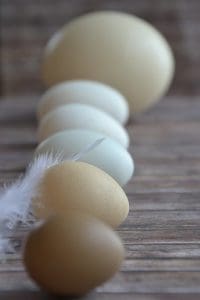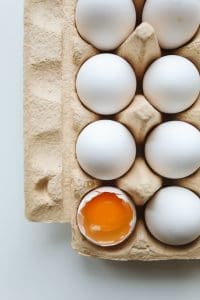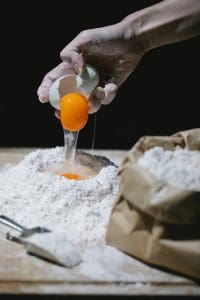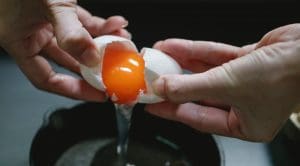Egg yolk, the best part of the egg
The yellow inside of an egg is called yolk or egg yolk. This yolk is about 1/3 of the weight of an egg. Sometimes chickens lay eggs with two yolks in them, or just zero. Often this has to do with the age of the chicken. The yolk is the place in the egg where most of the calories, vitamins, fats and minerals are stored. When the egg is fertilized, the chick emerges from this and all of these healthy nutrients are then for the chick. The primary function of the egg white is to protect the egg yolk from harmful microorganisms which it does through bactericidal enzymes called lysozyme.

The color of the egg yolk is also mostly determined by the chicken’s diet. When a chicken eats a lot of corn, the yolk will be a darker color. Also, if the chicken picks up a lot of outdoor larvae, insects and grass, the yolk will become darker. You see this a lot with omega-3 eggs where the chickens are mostly outdoors in woods and or pasture. Eating a lot of barley or wheat will give it a bright, well known, yolk color. Dye also plays a role in the color. Dye in the feed results in the color of the entire egg, or even chick.
Green egg yolk?
When you cook an egg, sulfur is created in the egg white. In the egg white there is iron, this iron together with the resulting sulfur gives a chemical reaction. This is why if you cook the egg for too long you will get a green-blue edge or stain on the egg yolk. This can also happen when making scrambled eggs, due to the iron in the pan and the sulfur in the egg. Neither reaction hurts your health or the taste of the egg.
Nutritional value egg yolk
The main nutrients of an egg are in the egg yolk. An average egg weighs 50 grams, of which the egg yolk is 15 -17 grams. Below you can see what all is in 15 grams of egg yolk:

Energy 54 kcal
Fat 4,9 g
– of which saturated 1,6 g
Carbohydrates 0 g
– of which sugars 0 g
Fibers 0.0 g
Protein 2.5 g
Salt 0.02 g
There are also a lot of vitamins in this part of the egg. They are rich in vitamin A, B2, B12 and vitamin D. They are also rich in various minerals such as phosphorus, folic acid, iron and zinc. Eggs are therefore a good vegetarian choice. An egg is one of the few foods that contains vitamin D. Vitamin D is good for bones, teeth muscles and resistance.
The egg yolk consists mainly of protein and unsaturated fat. Onverzadigd vet is goed voor je gezondheid. In de tabel hieronder zie je een overzicht van de verdeling van de voedingsstoffen in de eidooier en het eiwit. Deze tabel komt van het Amerikaanse Departement van Landbouw, de USDA.
| Nutrient | White | Egg yolk | % total in white | % total in egg yolk |
| Protein | 3.6 g | 2.7g | 57% | 43% |
| Fat | 0.05g | 4.5g | 1% | 99% |
| Calcium | 2.3 mg | 21.9 mg | 9.5% | 90.5% |
| Magnesium | 3.6 mg | 0.85 mg | 80.8% | 19.2% |
| Iron | 0.03 mg | 0.4 mg | 6.2% | 93.8% |
| Phosphorus | 5 mg | 66.3 mg | 7% | 93% |
| Potassium | 53.8 mg | 18.5 mg | 74.4% | 25.6% |
| Sodium | 54.8 mg | 8.2 mg | 87% | 13% |
| Zinc | 0.01 mg | 0.4 mg | 0.2% | 99.8% |
| Copper | 0.008 mg | 0.013 mg | 38% | 62% |
| Mangaan | 0.004 mg | 0.009 mg | 30.8% | 69.2% |
| Selenium | 6.6 mcg | 9.5 mcg | 41% | 59% |
| Thiamine (B1) | 0.01 mg | 0.03 mg | 3.2% | 96.8% |
| Riboflavin (B2) | 0.145 mg | 0.09 mg | 61.7% | 48.3% |
| Niacin (B3) | 0.035 mg | 0.004 mg | 89.7% | 9.3% |
| Pantothenic Acid (B5) | 0.63 mg | 0.51 mg | 11% | 89% |
| B6 | 0.002 mg | 0.059 mg | 3.3% | 96.7% |
| Folaat/Foliumzuur (B11) | 1.3 mcg | 24.8 mcg | 5% | 95% |
| B12 | 0.03 mcg | 0.331 mcg | 8.3% | 91.7% |
| Vitamine A | 0 IU | 245 IU | 0% | 100% |
| Vitamine E | 0 mg | 0.684 mg | 0% | 100% |
| Vitamine D | 0 IU | 18.3 IU | 0% | 100% |
| Vitamine K | 0 IU | 0.119 IU | 0% | 100% |
| DHA and AA | 0 | 94 mg | 0% | 100% |
| Carotene | 0 mcg | 21 mcg | 0% | 100% |
As you can see, the egg yolk has many nutrients but the total egg gives the most complete nutrients.
In addition, the yolk of an average egg contains about 186 mg. of cholesterol. Cholesterol is a building block for your body cells, it strengthens the cell walls but it is also a building block for making hormones. Vitamin D is also made from cholesterol under the influence of ultraviolet light. But too much cholesterol increases the risk of cardiovascular disease.
However, recent research shows that the cholesterol level in the blood is not so much increased by eating eggs but more by eating fatty foods such as cheese, sausages, whole milk products, processed meat and salty snacks. Products high in saturated fat. Cholesterol is mostly produced by the liver and a minority is absorbed from food. On the site of the nutrition center you will find more detailed information.
About cholesterol, we know it in two variants. LDL and HDL. The former is the unhealthy variety and HDL the healthy variety. Eating unsaturated fatty acids increases the amount of the healthy HDL. We find these in fatty fish (salmon, herring, mackerel, sardines), avocados, nuts and olives. And, of course, in eggs.
Where LDL causes narrowing of the blood vessels by sticking to the inside of the veins, HDL carries away excess LDL cholesterol. Besides the amount of LDL and HDL, the ratio between the two also plays an important role. More cholesterol where the mutual ratio remains strong is less harmful.
The egg yolk also contains the very healthy omega-3 unsaturated fatty acids. A family of different unsaturated fatty acids where ALA, DHA and EPA are the three most important. The first is found in nuts, soybean oil, flaxseed and linseed oil and the last two are common in oily fish, seafood and shellfish. The body itself makes limited DHA and EPA from ALA but most of it must still come from our diet.
ALA is a so-called essential unsaturated fatty acid. The body cannot make it itself. Algae also contain a lot of ALA but we get it most indirectly through fish. Fish convert ALA into DHA and EPA. DHA and EPA are also found in fish oil supplements, but it has not been demonstrated that they have the same healthy effect as eating fish. So possibly or probably there are other substances in fish that are very good for our health. More on the nutritional value of eggs. Translated with www.DeepL.com/Translator (free version)
Pickled egg yolks
To give a dish like pasta or even fish some more flavor, you can add a pickled egg yolk. This is basically a grated egg that you can put over your dishes. It is considered an Umami, which is appropriate considering the 8 day preparation time… This pickled egg is prepared as follows:
Ingredients
- 2 egg yolks
<175 grams of salt <125 grams of sugar
- Mix the salt and sugar. Pour half of this into a baking dish;

- Make 2 dimples with the back of a spoon and place the egg yolks in them. Cover this with the other half of the salt-sugar mixture;
- Go with cling film but make sure that some air can get in.
- Place this in the refrigerator and leave the dish for 4 to 8 days;
- Gently take them yolks out, and clean them with cold water. Then pat them dry;
- Lay the yolks in the oven for 1.5 to 2 hours at 65 degrees;
- Bewaar de eieren tot maximaal een maand in een luchtdichte bak in de koelkast;
- Rasp de dooiers over je gerecht.
Egg yolks left over?
Many recipes call for adding egg whites. Unfortunately, that leaves you with the egg yolk. A shame to throw it away. You can still make plenty of tasty things with it! Think for example of mayonnaise, custard or a lemon curd…
Storage period
It’s fun to make something from the yolks, but it is useful to know how long you can store them first. If you want to store them in the short term you can just keep them in the refrigerator, here they stay good for 2 to 3 days. Remember to put them in a layer of water or oil, because egg yolks dry out quickly.
Longer term storage is also possible; with about 6 grams of sugar or salt per 100 grams of egg yolk. This depends on how you want to use them afterwards (sweet or savory). This way you can keep them in the freezer.
What can you think of when you want to make something from egg yolks?
- Vanilla pudding
- Aioli
- Crème brûlée
- Hollandaise sauce
.
1. Mayonnaise
How do you make a tasty mayonnaise from an egg yolk? A nice recipe:
1 egg yolk of course, at room temperature
1 teaspoon mustard
1 tablespoon vinegar
150 ml sunflower oil
Little bit of salt
Hand blender or at least a whisk
Put the egg yolk in a bowl or tall measuring cup. Add the salt, mustard and vinegar. Stir briefly with the hand blender or whisk. The former goes faster. Add a little oil drop by drop and mix well. Haste is not good here either. Put this homemade mayonnaise in a container and serve it for example with fresh French fries.
Prevent the mayonnaise from drying out by putting it covered in the refrigerator.
2. Vanilla pudding
5 egg yolks
2 heaped tablespoons cornstarch
5 dl milk
1 dl whipped cream
2 vanilla pods
75 grams of sugar
This is how to make a tasty vanilla pudding:
Heat milk and whipping cream in a thick-bottomed saucepan. Cut the vanilla pods in half and scrape out the inside (the marrow). Add both sticks and marrow to the milk. Beat the egg yolks with the sugar and cornstarch.
When the milk is boiling, remove the sticks from the milk. Add a good amount of hot milk to the egg yolks and stir. Pour the mixture into the pan. Turn the heat down as low as possible. Leave the vanilla pudding on the heat for another half minute. Keep stirring!
Pour the pudding over into a large bowl or several small ones. The vanilla pudding is very tasty both hot and cold. For the cold vanilla pudding, cover the warm pudding immediately with foil and then refrigerate. Otherwise, a sheet will form on the pudding. Unless you like that of course. Both cold and hot delicious with chocolate and red fruit.
3. Ai oil
1 egg yolk
250 ml sunflower oil
Garlic cloves
Lemon juice or pickle juice
Salt and pepper
Place the egg yolk in a bowl or tall measuring cup along with 1 or 2 finely chopped garlic cloves and mix well with a whisk. While stirring, add about 50 milliliters of oil drop by drop.
If all goes well, the aioli will now begin to rise in the bowl. If this is not happening yet keep adding oil drop by drop while continuing to whisk.
Continue beating and now add the remaining oil. When the aioli has the thickness of mayonnaise the base product is ready. Season with salt, pepper and lemon juice.
4. Crème brûlée
PORTIONS: 6 portions
Small baking dishes 6 to 7 cm in diameter.
5 egg yolks
80 grams granulated sugar
500 ml whipped cream
Cane sugar
1 vanilla pod
Remove the egg yolks from the egg shells and combine them with the granulated sugar in a bowl. Mix both together well with a whisk. Pour the whipping cream into a saucepan. Cut the vanilla pod lengthwise, remove the marrow and add it to the whipping cream.
Bring the cream to a boil while stirring, then pour in the egg yolk and sugar mixture. Keep stirring.
Divide the result over the oven dishes. Put the oven dishes in a baking dish and pour in a layer of hot water.
Preheat the oven to 150 degrees. Put the dish with trays in the oven and bake the crème brûlée in 45-50 minutes at the same temperature. Check whether the result after 50 minutes is sufficiently firm, otherwise put them back.
Leave them to cool outside the oven and then put them in the fridge to set. Assume at least 3 to 4 hours in the refrigerator. Then take them out of the fridge and sprinkle the cane sugar in a thin layer over them. Not everyone has a gas burner to burn the sugar layer. Just place back in the oven and when the sugar turns brown take them out.
5. Hollandaise sauce
3 egg yolks
2 tablespoons vinegar
4 tablespoons dry white wine
250 grams melted butter
Pepper and salt
Beat the egg yolks with the vinegar and white wine for 5-10 minutes. Slowly add the melted butter to the egg yolk mixture. The important thing is to keep whisking constantly. Also, constantly go over the bottom of the pan with the whisk to prevent the egg yolks from sticking to the bottom and burning. When the mixture becomes so stiff that you can find the traces of the whisk in it, the sauce is ready. Season the Hollandaise sauce with salt and pepper. You can also add a little lemon juice.
6. (Vanilla) ice cream
The lecithin from yolks acts as an emulsifier in the ice cream so that the water and fat mix well. Also, the proteins from the milk / cream and from the yolk for airier ice cream.
4 egg yolks
1 vanilla pod
300 ml milk
200 ml whipped cream
110 gr sugar
Cut the vanilla pod lengthwise and scrape out the marrow. Add this together with the milk and cream and bring to the boil. Then put the egg yolks with the sugar in a bowl and stir together briefly. Pour the milk/whipped cream mixture onto the egg yolks while stirring and continue to stir. Now fish the vanilla pod out of the mixture. Heat the mixture on low heat in a pan and stir just as long as the whisk draws visible traces in the mixture. It is important that you do not let the mixture boil.
Let it cool completely on the counter and then put it in the refrigerator overnight. If you want to enjoy your ice cream sooner make sure the mixture is in the fridge for at least 6 hours. The result can now be put in the ice cream machine.
Of course, this recipe can also be made into other variants than vanilla ice cream. From hazelnut, cinnamon, ginger, forest fruits and cherries to the addition of whiskey. Experiment for your favorite combination of ice cream.
